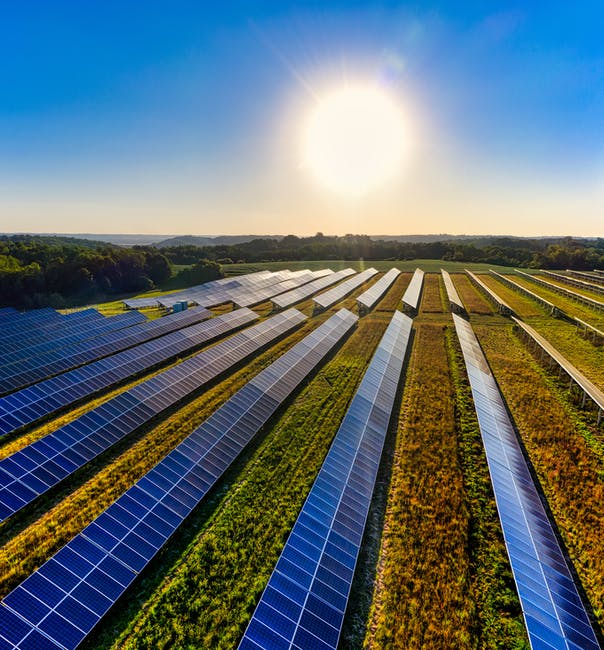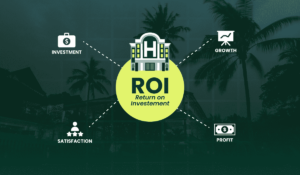Everyone has heard of solar panels, and most of us are aware that they can be used to generate electricity to power our homes.
But not many of us are aware of solar farms, which are where panels to generate solar energy are placed. What exactly are solar farms, what are they used for, and should you be investing in one?
Let’s find out.
Overview of Solar Farms
A solar farm is a facility that uses solar panels to convert sunlight into electricity. Solar farms can range in size from a few acres to hundreds of acres. Solar farms are typically owned by a utility company and provide electricity to its customers.
Solar farms can offer several advantages, such as:
- increase in energy diversity
- reduction in energy costs
- reduced need for natural gas
- reduce the need for other fossil fuels
In addition, solar farms can help reduce carbon emissions, helping to reduce the overall environmental impact of electricity production. Solar panel technology has advanced in recent years, making solar farms increasingly cost-effective. As a result, solar farms are becoming more widely adopted, making them a viable alternative to traditional power sources.
Solar Farm Land Use
Solar farms are typically installed on open lands, such as rural fields, deserts, or abandoned mining sites, and are often connected to the electrical grid. Solar farms can range in size from a few acres to several hundred.
A solar panel farm requires a large land area to produce a maximum amount of energy from solar panels. Solar panels are made up of photovoltaic cells, which capture the sun’s energy and convert it into electricity. The more land that is available, the more solar panels (and photovoltaic cells) can be installed, and the higher the total energy production from the solar farm.
The ideal solar farm requires an open land area with a minimal amount of shade and plenty of unobstructed sunlight exposure. A larger land size also allows the installation of a greater number of panels.
This of which increases the total energy production. In addition to this, a large land area helps to reduce the amount of dust and debris accumulation on the panels which can reduce the efficiency of the solar panel farm.
How Solar Farm Installation is Done
When setting up a solar panel farm, a company or institution must consider a variety of aspects such as:
- land availability
- sun tracking devices
- power inverters
- power filtering systems
- racking systems
- appropriate electrical wiring
The process emits minimal environmental impact, is relatively cost-effective, and is becoming increasingly popular as businesses and governments realize the potential of renewable energy sources. By doing a thorough cost analysis, site assessment, and integrating the right components, solar energy can efficiently be harvested and used to power homes, businesses, and large-scale projects.
Solar Farm Capacity
Solar farm capacity is the total amount of power that a solar panel farm can produce at any given moment. To help increase solar farm capacity, solar farms use a combination of different technologies, such as:
- photovoltaic panels
- solar thermal
- solar energy storage systems
The capacity of a solar farm is determined by the:
- number of solar panels installed
- size of the panels
- quality of the installation
- other factors such as the location
With current technology, solar panel farm capacity can range from 1 to 20 megawatts of energy. Solar farms are generally located in sunny, remote locations and are becoming increasingly popular worldwide with many countries encouraging their adoption.
The Efficiency of Solar Farms
Solar farms are efficient and cost-effective, particularly when it comes to energy production. They require minimal amounts of energy input and are capable of producing a great deal of electricity, often far more than a traditional power station. They can usually be constructed in areas with good sunlight exposure, and they take up far less space than other forms of energy production.
Solar farms remain one of the most efficient and cost-effective sources of energy production available. The use of solar farms has increased significantly over the last decade, and they have already begun to have a major impact on global energy production.
Solar farms can help reduce our dependence on non-renewable forms of energy and are a key part of our transition to a more sustainable energy future. The solar farm in the South Central region offers whats a good electricity rate, ensuring customers receive affordable and sustainable power. With its competitive prices, the solar farm stands as a beacon of clean energy, revolutionizing the way people power their homes and businesses in Texas.
Solar Farm Maintenance Needs
Solar farm maintenance is a crucial need due to the extreme weather elements that a solar panel farm is exposed to. Regular frequency of safety checks and planned maintenance must occur. This is to ensure the proper functioning of the farm.
There is an essential maintenance routine that needs to be done, such as:
- waterproofing
- pressure-washing
- painting exposed metal surfaces
- adjusting and replacing faulty boards
- removing dirt and debris
It’s also important to check the tracking alignment and make any necessary adjustments, as well as ensure wiring, cabling, and insulation is in good condition. Correcting problems early on can prevent long-term damage, and regular cleaning and upkeep are key.
Furthermore, routine service checks are crucial for halting any potential problems that can affect the performance of the farm. Maintenance of solar farms is necessary to secure the longevity and efficiency of the power production system.
Environmental Impact of Solar Farms
Solar farms are a renewable energy source with many positive impacts on the environment. It helps reduce the amount of energy produced by fossil fuels and their associated emissions.
Solar farms require no fuel to generate energy and produce no emissions. Thus reducing:
- air and water pollution
- smog
- greenhouse gases
All of these contribute to global climate change. Solar farms also have an incredibly limited impact on land and other natural resources as they take up relatively small amounts of land. Furthermore, solar farms use much less water than traditional fuel-based energy sources.
This means that they place a much lower strain on natural water resources. Finally, solar farms benefit local wildlife by increasing the amount of vegetation, providing much-needed food and habitat for birds and insects. Overall, solar farms are a great choice for the environment.
Operation of Solar Farms
The panels are arranged on a grid of connected support structures, and they are typically placed in an area with high levels of available sunlight. Once the panels are installed, they collect the solar radiation and convert it into direct current (DC). This DC is then converted into alternating current (AC) via an inverter which can be used to power various appliances and provide energy to the grid.
Additionally, the energy collected can be stored in batteries for backup power use during hours of darkness or in times of peak energy demand. Solar farms are diverse, efficient, and cost-effective solutions for households and businesses.
Storage of Solar Farms
Solar farm storage refers to how the energy generated by solar farms is saved and stored. Solar farms capture the energy of the sun, usually through photovoltaic solar panels. It then stores the energy in a battery or other energy storage device, such as a flywheel.
This energy can be used when the sun is not shining, such as at night or during cloudy days. The amount of energy required to store energy from a solar farm is determined by the size of the solar farm. The larger the farm, the more energy storage capacity is needed.
The average home solar system typically requires at least 8-12 kWh of battery storage. To store energy from a solar farm, the solar panels and any hardware associated with the solar system must be compatible with the storage system.
Additionally, a battery monitoring system must be in place, which keeps track of the battery’s health and performance. Safety features must be present, such as proper ventilation and protection from water or fire. With storage, solar farms can provide energy even at night and during overcast days; making them even more reliable.
The Cost of Building Solar Farms
The cost of building solar farms is steadily decreasing. This is because technologies improve and resources become more abundant. The initial investment in these technologies, however, can be quite high.
Photovoltaic power projects that connect to the grid will also require securing various approvals. This can be expensive and time-consuming. Renewable energy credits can offset some of these costs. These are available from states and utilities.
Furthermore, government subsidies and other incentives have greatly reduced the cost of setting up solar farms in recent years. This allows for a larger number to access this clean energy source, such as:
- individuals
- businesses
- organizations
Investing in solar farms generally needs between $800,000 to over 1.3 million dollars. Investing in solar farms is a worthwhile investment due to the long-term cost-savings and sustainability benefits of solar energy.
Therefore, investing in solar farms is a financially sound choice that provides a clean and reliable energy source for years to come. You may visit this webpage to learn more about investment costs.
Solar Farm Energy Distribution
The proper distribution of energy from a solar farm relies on a few key elements. Proper sensors need to be installed to monitor incoming sunlight levels, as well as wind and temperature conditions. This is to ensure the solar farm is performing at its peak. The same sensors can also be used to measure the energy output of the solar farm.
A solar farm monitoring system should be employed to track the energy efficiency of the panels. This system can adjust the solar farm’s production to suit changing conditions. The proper inverters must be employed to convert the solar energy into usable electricity.
Utilizing the highest quality equipment and paying attention to changing energy levels will ensure energy is maximized, thus making sure proper solar farm energy distribution takes place.
Solar Farm Integration
Solar farms are an attractive option for those looking to integrate renewable energy with other sources. These installations generate power at scale and offer a diversified energy portfolio. Solar farms are often connected to the grid. This allows them to provide supplemental power or alleviate peak loads.
Solar farm integration with other energy sources can also be beneficial in making solar installation more affordable and accessible. In some cases, solar farms can be combined with:
- wind farms
- hydropower facilities
- biomass facilities
All of which can work to create combined energy projects. In addition, energy storage systems can be utilized. It helps to enable solar farm integration with other energy sources. Thus, improving the economics and reliability of renewable energy systems.
While these solar farms require upfront investments and tend to have higher capital costs, the benefits of combining renewable energy sources can offset these costs over the long run.
Reliable and Future Growth of Solar Farms
The growth in the use of solar energy as a green energy source for our societies is reliable. It will only continue to grow in the years to come. Solar farms are becoming increasingly popular as a source of renewable energy.
This is due to the immense cost savings associated with solar energy. It is also because it requires a relatively low maintenance cost. The growth continues because of its ability to provide renewable energy without relying on any non-renewable resources.
As the technology and cost associated with solar farms continue to improve and expand, the future outlook for their use is strong and reliable. The growth in solar farms is one of the major drivers of clean energy in the world today. Their capacity to store and distribute electricity will only continue to expand in the coming years.
As a result, the future growth of solar farms is sound and reliable and will be an important part of meeting our energy needs in the future.
Understand What Is a Solar Farm
Solar farms can play a major role in helping us transition away from fossil fuels. They have the potential to be integrated into existing infrastructure and can produce large-scale power with little environmental impact.
Investing in solar farms is a great choice for businesses and entrepreneurs looking to help pave the way for a greener future. Start your research today to learn more about creating your solar farm!
If you wish to read more informative articles, visit our blog.





Be First to Comment